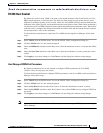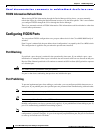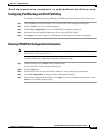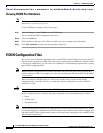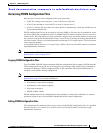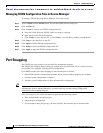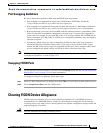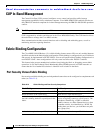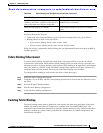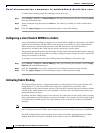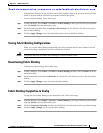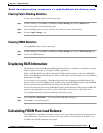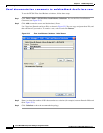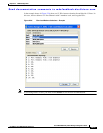
Send documentation comments to mdsfeedback-doc@cisco.com.
22-20
Cisco MDS 9000 Family Fabric Manager Configuration Guide
OL-6965-03, Cisco MDS SAN-OS Release 2.x
Chapter 22 FICON Configuration
CUP In-Band Management
CUP In-Band Management
The Control Unit Port (CUP) protocol configures access control and provides unified storage
management capabilities from a mainframe computer. Cisco MDS 9000 FICON-enabled switches are
fully IBM CUP standard compliant for in-band management using the IBM S/A OS/390 I/O operations
console.
Note The CUP specification is proprietary to IBM.
CUP is supported by switches and directors in the Cisco MDS 9000 Family. The CUP function allows
the mainframe to manage the Cisco MDS switches.
Host communication includes control functions such as blocking and unblocking ports, as well as
monitoring and error reporting functions.
Fabric Binding Configuration
The Cisco MDS SAN-OS Release 1.3(x) fabric binding feature ensures ISLs are only enabled between
specified switches in the fabric binding configuration. Fabric binding is configured on a per-VSAN basis
and can only be implemented in FICON VSANs. You can still perform fabric binding configuration in a
non-FICON VSAN—these configurations will only come into effect after FICON is enabled.
This feature helps prevent unauthorized switches from joining the fabric or disrupting current fabric
operations. It uses the Exchange Fabric Membership Data (EFMD) protocol in FICON networks to
ensure that the list of authorized switches is identical in all switches in the fabric.
Port Security Versus Fabric Binding
Port security and fabric binding are two independent features that can be configured to complement each
other (see Table 22-2).
Table 22-2 Fabric Binding and Port Security Comparison
Fabric Binding Port Security
Uses a set of sWWN and a persistent Domain ID. Uses pWWNs/nWWNs or fWWNs/switch WWNs.
Binds the fabric at the switch level. Binds devices at the interface level.
Authorizes only the configured sWWN stored in
the fabric binding database to participate in the
fabric.
Allows a preconfigured set of Fibre Channel
devices to logically connect to a SAN port(s). The
switchport, identified by a WWN or interface
number, connects to a Fibre Channel device (a host
or another switch), also identified by a WWN. By
binding these two devices, you lock these two ports
into a group (list).
Activation is required on a per VSAN basis. Activation is required on a per VSAN basis.




